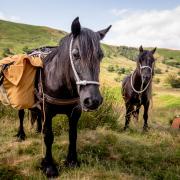Our intrepid reporter joined a riot and had a close encounter with the giant police horses who help keep the county safe.

They canter out of swathes of blue smoke and the yelling hooligans beat a hasty retreat, stumbling and clutching on to each other as they look fearfully over their shoulders.
The yobs had been noisy, aggressive and armed with missiles but the mood changes dramatically as six enormous police horses approach and their heavily protected riders in full riot gear shout: 'Go back, go back NOW.'
It's a scene that has been played out at riots and incidents of civil disorder across the country, so where did this latest clash take place? At a city centre protest or rally, maybe, or in the streets near a football stadium? No, this threatening crowd had gathered on a tree-fringed lane in the peaceful countryside at Hutton.
And most of the 'yobs' were trainee police officers taking part in an exercise at Lancashire Constabulary's Mounted Unit HQ which would help them learn about the unit's work.

Also in the crowd were Lancashire's High Sheriff, Ralph Assheton, and me, his wife Olivia, on duty for Lancashire Life.
'You'll be part of a noisy, aggressive crowd of rioters,' said Inspector Rob Gomery. But does my husband get mown down by police horses while I stand at the back? Can I swear?' The answer to both is no, it seems.
The horses warmed up and then our "gang" turned itself into a that promised noisy, aggressive group. As the horses moved in, we were gently, but firmly, driven back and contained at walk, trot and canter. The mounted officers then split us into two smaller groups to simulate a situation where an ambulance needs to get through a crowd in an emergency and, still shouting and behaving badly, we threw soft balls at the horses and riders to simulate real missiles.
Smoke bombs were let off and the use of the riders' long batons was demonstrated. The latter, thankfully, are only ever deployed if 'the wheels have really fallen off', we were told.

Lancashire has the second largest mounted police division in England behind the Metropolitan Police. The county's high ranking speaks volumes about the quality of the horses, riders and their nationally acclaimed training regime. They, and their colleagues at the Dog Unit, will move to modern, purpose-built premises nearer to HQ at Hutton in the near future.
A typical day for the mounted division will be a standard 'tasking shift' of eight or nine hours, starting with 45 minutes at the stables to get ready, load hay, water and extensive public order gear. All the division's officers are HGV trained and take turns driving the horsebox. Riding skills courses take place twice a week in groups of two, four and six.
Because of the height of the horses, mounted's role in crime deterrence is key - they spot trouble from afar and inform colleagues on the ground, and will typically be seen at football matches or large crowd situations. Our demonstration also showed how officers arrest suspects while on horseback.
While the division's priority is Lancashire, they often carry out 'mutual aid' for other forces and were present at the Olympics and President Trump's visit to Blenheim Palace. The division also carries out 'open searches' for vulnerable people and suspects, receiving descriptions just like other officers. These instances are quite rare, but with mobile phone tracking technology, they can sometimes reach remote areas more quickly than motorised units.

Horses are a minimum of 16.2 hands high and breeds include English and Irish Draughts, Irish Sports horses and Spanish Norman (a cross between Andalusian and Percheron). They normally arrive backed, aged between four and five, but the exception to this is 'Argent', a beautiful 10-year-old grey who came on loan and is now a fixture. He stands a whopping 18.2 hands and is their tallest horse.
Horses are usually named after a Lancashire town and are cared for by their riders and the police staff grooms who work at the centre.
And who wants to be a mounted policeman? Many young officers with an interest in horses or who are keen riders apply,' says Rob. 'There are also seasoned police officers that might have been in the job for 12 or 15 years and want to try the mounted division.'
An initial 16-week course is mandatory for all PCs - whether they have previously ridden or not - and training continues as the matched horses and riders progress through 'standard', 'intermediate' and advanced stages.

The horses rest for one or two weeks a year and have a day off a week - usually on a Sunday. There's also the occasional 'horsy treat', such as a recent a day out at Somerford Park Farm's cross-country course in Cheshire.




























